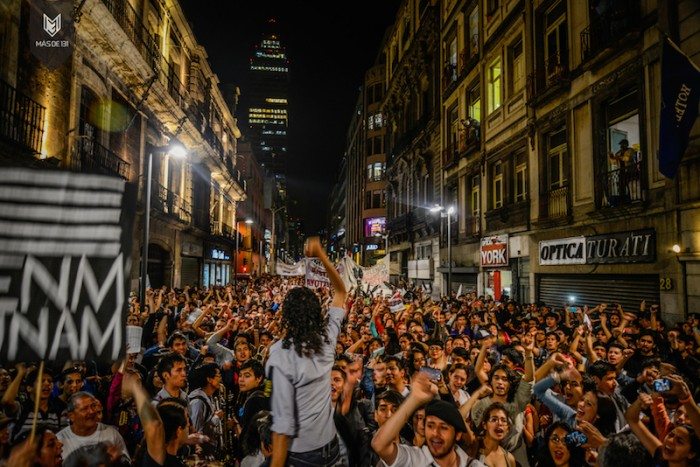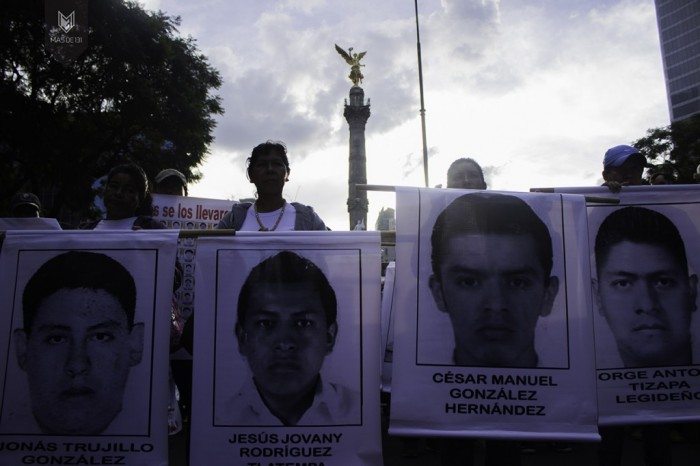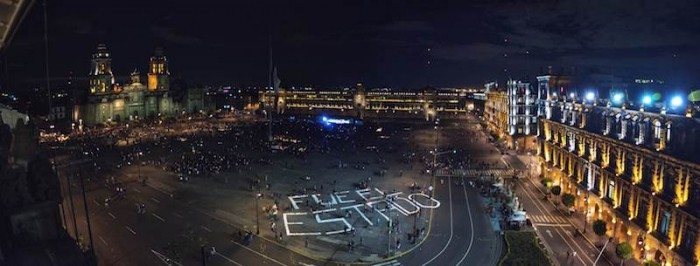Editor’s Note: We received the following essay last night from political activist Meztli Yoalli Rodríguez Aguilera, originally from Mexico City and currently studying in the United States. The images featured are courtesy of MásDe131, a site that covers Mexico’s protest movement.
Submitted to LatinoRebels.com by Meztli Yoalli Rodríguez.
Comparto artículo que escribí para @latinorebels sobre Ayotzinapa y la violencia de Estado en México. #YaMeCanse http://t.co/CjwqvISKZZ
— M. Yoalli Rodríguez (@MeztliYoalli) November 10, 2014
“They took them alive, we want them back alive!”
This is the chant resonating around the world these days. More than 40 days have passed since 43 students disappeared in Iguala, México. On September 26, these students from the Raúl Isidro Burgos Normal School (Escuela Normal Rural) went from Ayotzinapa (where they live and study) to the city of Iguala. They were fundraising to attend the commemoration ceremonies of October 2, 1968, a date in which Mexican students were killed, tortured and incarcerated by the Mexican government.
The Normales Rurales emerged as a political project of the Mexican state in the 1920s. The objective was for rural communities to have access to education since students would become professors to serve their communities. These schools were also the roots of social and political transformation. Two important figures graduated from Ayotzinapa’s Normal School: Lucio Cabañas Barrientos (Party of the Poor) and Genaro Vázquez Rojas (National Revolutionary Civic Association), two important guerrilleros in Mexican history.
This tradition of dissident voices has continued until this day, despite several attempts by Mexican presidents to try and squash them. Today, of the 29 original Normales Rurales, only 17 exist. On September 26, while the students were in Iguala, police cars opened fire on them, killing six people. Anothere 43 students were put in police cars, and that was the last time everyone saw them. Their present whereabouts are unknown.
Since the drug war began in Mexico in 2006, more than 20,000 people have disappeared without a trace. According to official numbers, from 2007 to 2012 there were more than 121,000 homicides, and more than 50,000 since the current government of Enrique Peña Nieto rose to power.
The numbers are frightening, but we need to give faces and voices to the people that have vanished: Who were they? What did they do for a living? Were they students or workers? What were they dreams? What made them sad or happy? The term narcopolitics has been used to describe how narcotraffic and government are mutually imbricated. I consider that we are now in a state of necropolitics: the power exercised to decide who lives and who dies.
Abel García Hernández is 19 years old. He comes from Tecuanapa, Guerrero. His father, a farmworker, has been looking for him since he disappeared and still has hopes to find him alive. Marcial Barando is 20 years old and comes from Costa Chica, he was in the Normal Rural, preparing to become a bilingual professor (Spanish and an indigenous language). Benjamín Asencio Bautista, 19 years old, is from Chilapa and he was a communitarian educator before joining the Normal Rural. José Ángel Campos Cantor, 33 years old, comes from Tixtla Guerrero.
These are only four names and faces of 43 students that are still missing. (You can read more stories here.)
These are indigenous students fighting for a better life, for an education engaged with a social and political reality. On November 7, Jesús Murillo Karam, the attorney general of the Mexican federal government, organized a press conference about the missing students and, based on the testimonies of two detainees, claimed they were murdered. He closed the conference with the phrase, “Ya me cansé” (“Enough, I’m tired”). Almost immediately, the phrase became a hashtag and a trending topic on Twitter. People used it to express their fatigue of Mexican society towards their violent, corrupt and lying government: #YaMeCanséDeTenerMiedo (“I’m Tired of Being Afraid”).
The families of the missing students claim they want their sons alive and demand irrefutable evidence of their deaths before making a conclusion. They refuse to accept only testimonies from those detained.
We, as students and as society, are with them. You don’t mess with human pain. The organization of several protests (around 100 each time) in cities around the world and Mexico demand the finding of the 43 missing students in Mexico, as well as the punishment of the culprits.
A monumental tag was written in the main square of Mexico City: Fue el Estado (It was the State). This is our main claim. Even if they already incarcerated the local mayor of Iguala, José Luis Abarca, many responsible parties are still free. The local and federal governments are part of the same State, so the Mexican State is the direct responsible for the 43 missing students since they were in police cars, the workers of the government, the last time they were seen. Time is running short.
The pain is growing, but also indignation. In a protest on November 8, the door to the National Palace was on fire in Mexico City but also there were arbitrary detention of students by policemen. Something is clear: Mexico is in pain and enraged. We have to keep an eye on the central subject here: Ayotzinapa is not a closed case. Conversely, with Ayotzinapa and the 43 missing students,
Mexico is writing another history. Mexico is alive. Protests, music, global actions, letters, hashtags, websites, meetings, organizations, vigils, murals—spreading to the world and across borders. Resistance comes from different paths. They are them, but we are them. Their pain is our pain. Their rage is our rage. Nontheless, their hope is also ours. Until justice arrives, we will remember the stories and faces of each of the 43 students. Memory is our way of resisting. They won’t silence us.
“They took them alive, we want them back alive!”







[…] of over a dozen student activists by local police in Iguala, Guerrero. As Yoalli Rodríguez has pointed out eloquently, the “normal” schools where the activists studied were created in the 1920s in the wake of the […]
[…] of over a dozen student activists by local police in Iguala, Guerrero. As Yoalli Rodríguez has pointed out eloquently, the “normal” schools where the activists studied were created in the 1920s in the wake of the […]
[…] is an event inspired by the Austin-based support for the #ayotzinapasomostodos letter, the Global Days of Action for Ayotzinapa, and the ongoing assembly of a Global Forum “Mexico: the Wound of the World.” On the first day […]
[…] all segments of Mexican society – people who are tired of the never-ending violence. More than 20,000 people have disappeared in Mexico since the beginning of the drug war in 2006. 100,000 people have […]
[…] outlets reported that the FBI assisted Mexican officials in the investigation of the #Ayotzinapa case in […]
[…] 1: Iguala. The news from Mexico led to some of the most powerful pieces we published this […]
[…] perhaps one of the most decisive reader polls we ever conducted, our readers have named the #Ayotzinapa protests as the top Rebeldes story of […]